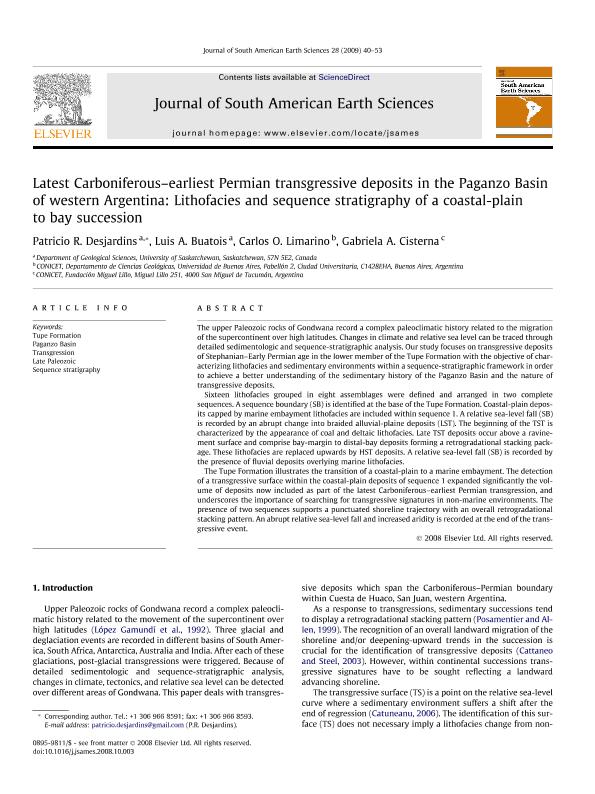Artículo
Latest Carboniferous-earliest Permian transgressive deposits in the Paganzo Basin of western Argentina: Lithofacies and sequence stratigraphy of a coastal-plain to bay succession
Desjardins, Patricio R.; Buatois, Luis Alberto ; Limarino, Carlos Oscar
; Limarino, Carlos Oscar ; Cisterna, Gabriela Adriana
; Cisterna, Gabriela Adriana
 ; Limarino, Carlos Oscar
; Limarino, Carlos Oscar ; Cisterna, Gabriela Adriana
; Cisterna, Gabriela Adriana
Fecha de publicación:
07/2009
Editorial:
Pergamon-Elsevier Science Ltd
Revista:
Journal of South American Earth Sciences
ISSN:
0895-9811
Idioma:
Inglés
Tipo de recurso:
Artículo publicado
Clasificación temática:
Resumen
The upper Paleozoic rocks of Gondwana record a complex paleoclimatic history related to the migration of the supercontinent over high latitudes. Changes in climate and relative sea level can be traced through detailed sedimentologic and sequence-stratigraphic analysis. Our study focuses on transgressive deposits of Stephanian-Early Permian age in the lower member of the Tupe Formation with the objective of characterizing lithofacies and sedimentary environments within a sequence-stratigraphic framework in order to achieve a better understanding of the sedimentary history of the Paganzo Basin and the nature of transgressive deposits. Sixteen lithofacies grouped in eight assemblages were defined and arranged in two complete sequences. A sequence boundary (SB) is identified at the base of the Tupe Formation. Coastal-plain deposits capped by marine embayment lithofacies are included within sequence 1. A relative sea-level fall (SB) is recorded by an abrupt change into braided alluvial-plaine deposits (LST). The beginning of the TST is characterized by the appearance of coal and deltaic lithofacies. Late TST deposits occur above a ravinement surface and comprise bay-margin to distal-bay deposits forming a retrogradational stacking package. These lithofacies are replaced upwards by HST deposits. A relative sea-level fall (SB) is recorded by the presence of fluvial deposits overlying marine lithofacies. The Tupe Formation illustrates the transition of a coastal-plain to a marine embayment. The detection of a transgressive surface within the coastal-plain deposits of sequence 1 expanded significantly the volume of deposits now included as part of the latest Carboniferous-earliest Permian transgression, and underscores the importance of searching for transgressive signatures in non-marine environments. The presence of two sequences supports a punctuated shoreline trajectory with an overall retrogradational stacking pattern. An abrupt relative sea-level fall and increased aridity is recorded at the end of the transgressive event.
Archivos asociados
Licencia
Identificadores
Colecciones
Articulos(IGEBA)
Articulos de INSTITUTO DE GEOCIENCIAS BASICAS, APLICADAS Y AMBIENTALES DE BS. AS
Articulos de INSTITUTO DE GEOCIENCIAS BASICAS, APLICADAS Y AMBIENTALES DE BS. AS
Citación
Desjardins, Patricio R.; Buatois, Luis Alberto; Limarino, Carlos Oscar; Cisterna, Gabriela Adriana; Latest Carboniferous-earliest Permian transgressive deposits in the Paganzo Basin of western Argentina: Lithofacies and sequence stratigraphy of a coastal-plain to bay succession; Pergamon-Elsevier Science Ltd; Journal of South American Earth Sciences; 28; 1; 7-2009; 40-53
Compartir
Altmétricas



